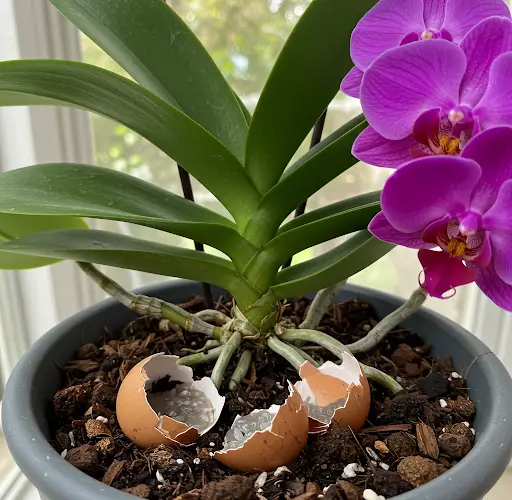Orchids are one of the most beautiful and delicate plants, but they require proper care to thrive. If an orchid becomes wilted, with wrinkled leaves and damaged roots, many people may discard it, thinking it cannot be revived. However, with the right techniques and natural remedies, it is possible to restore a dying orchid and encourage new growth. In this guide, I will show you step-by-step how to rejuvenate a wilted orchid using rice water, eggshells, and cinnamon powder.
Step 1: Assessing the Damage
The first step in reviving a wilted orchid is to assess its condition. If the leaves are wrinkled and wilted, and the roots appear rotten or dry, immediate action is needed.
- Begin by carefully removing the orchid from its pot.
- Inspect the roots to identify which ones are still viable and which ones are damaged.
- Any roots that are black, mushy, or hollow should be cut off using sterilized scissors or pruning shears.
- Remove all damaged leaves and flowers to allow the plant to focus its energy on recovery.
Step 2: Cleaning and Disinfecting the Orchid
Once the damaged parts have been removed, it is essential to clean and disinfect the orchid to prevent infections and fungal growth.
- Rinse the entire plant under running water to wash away any remaining debris.
- Sprinkle cinnamon powder on all the freshly cut wounds, including the roots and leaves. Cinnamon is a natural antifungal agent that helps wounds dry quickly and prevents infections.
- Allow the plant to rest in a cool, shaded area for a few hours to let the cuts dry completely.
Step 3: Preparing Rice Water and Eggshell Solution
Rice water and eggshell solution are excellent natural fertilizers that provide essential nutrients to support the orchid’s recovery.
Preparing Rice Water:
- Take 5 tablespoons of uncooked rice and soak it in 500ml of room temperature water.
- Stir well and let it sit for about 30 minutes.
- The nutrients from the rice, including vitamins A, B, and E, along with amino acids and minerals like phosphorus and potassium, will dissolve into the water.
- Strain the water and set it aside.
Preparing Eggshell Solution:
- Take the shells of 5 poultry eggs and place them in 500ml of boiled water.
- Cover with a lid and let it sit for about 2 hours to allow the minerals, such as calcium, to mix into the water.
- Strain the solution, removing the eggshell pieces, and set it aside.
Step 4: Soaking and Watering the Orchid
- Mix the prepared rice water with the eggshell solution to create a nutrient-rich liquid.
- Use this mixture to gently wash the orchid leaves, helping to remove fungi and insects.
- The combination of eggshells and rice water enhances the plant’s ability to absorb nutrients and promotes faster recovery.
- Place the orchid in a well-ventilated area away from direct sunlight to allow it to absorb the nutrients effectively.
Step 5: Repotting the Orchid
Now that the orchid is cleaned and nourished, it is time to repot it in a suitable growing medium.
- Use a pot with good drainage to prevent water retention, which can lead to root rot.
- Fill the pot with a mix of gravel and moss, which helps provide aeration and retains the right amount of moisture.
- Gently place the orchid in the new pot, ensuring that the roots are well-supported by the growing medium.
- Lightly mist the orchid to keep the growing medium moist but not waterlogged.
Step 6: Providing the Right Environment
- Keep the orchid in a cool, shaded place away from direct sunlight.
- Avoid watering for the first week to allow the plant to settle in its new environment.
- After one week, water the orchid once every 2-3 days using the rice water and eggshell solution.
- Ensure that the humidity around the plant remains at an optimal level by misting occasionally.
Step 7: Monitoring and Encouraging Growth
After about two months, the orchid should show signs of recovery.
- The plant will start growing new leaves, replacing the initial wilted ones.
- Strong roots will begin to develop, ensuring better absorption of water and nutrients.
- New buds may start to appear, indicating that the orchid is regaining its vitality.
At this stage, continue to care for the orchid as you would a healthy plant. Maintain a regular watering schedule, provide adequate light, and periodically use natural fertilizers to keep the plant strong.
Conclusion
Reviving a wilted orchid is possible with patience and the right approach. By removing damaged parts, disinfecting the wounds, and using natural fertilizers like rice water and eggshell solution, the orchid can recover and even thrive. With consistent care and a nurturing environment, the once-wilted orchid can grow strong roots, lush leaves, and beautiful flowers once again.
If you find this guide helpful, consider sharing it with other orchid enthusiasts to help them revive their plants as well!



